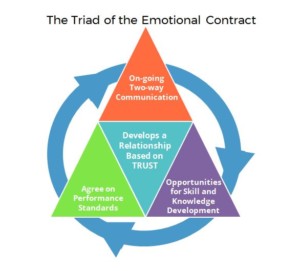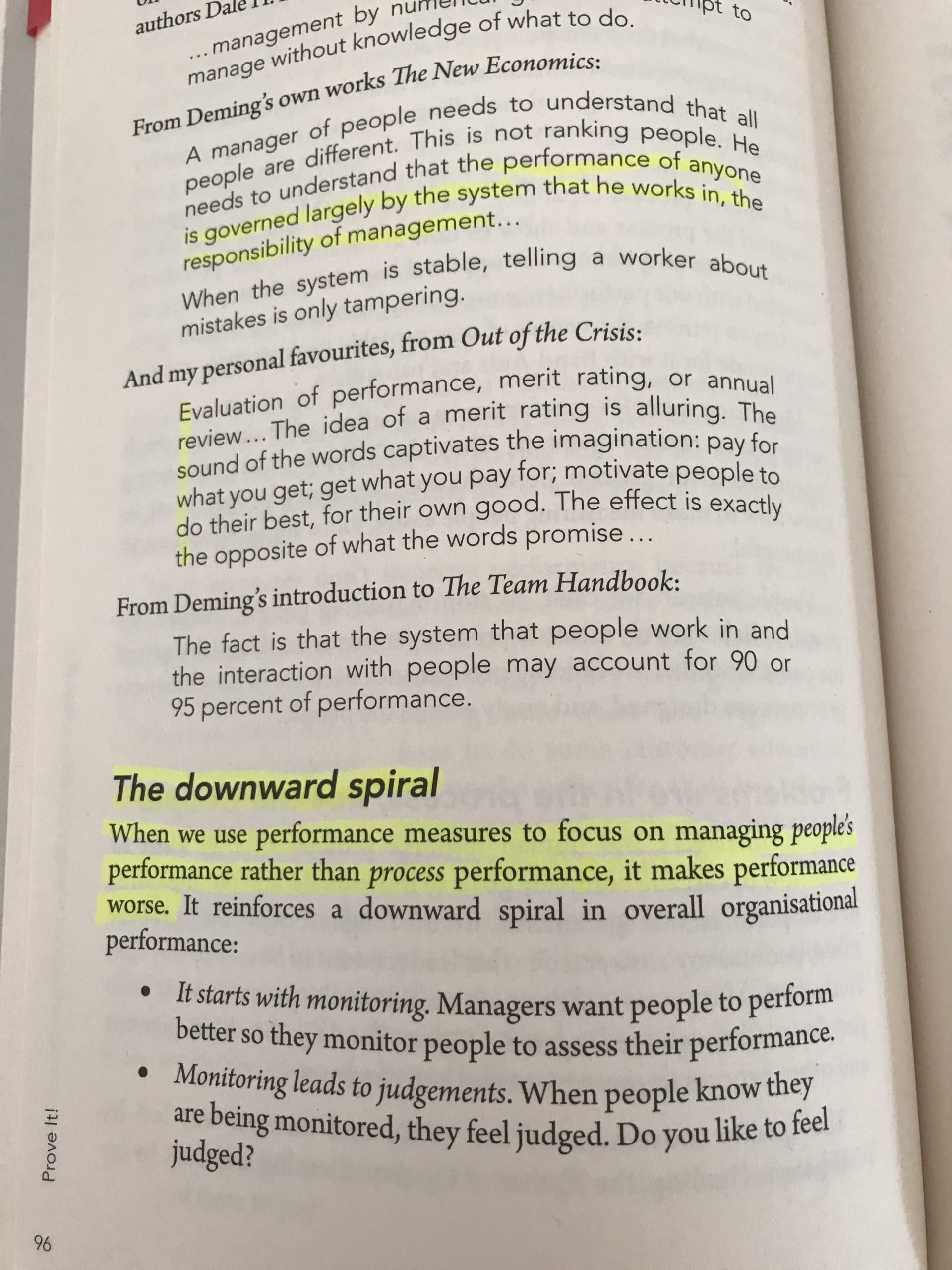“Performance management” brings very unpleasant experiences and consequences for managers, team leaders and team members. Coaching for performance is the new model.
The current practice of the annual or six-monthly review is coming to an end. Replacing it with coaching for performance will bring genuine human relationships based on trust back to the workplace.
What great times we live in. We are witnessing the end of the annual performance appraisal and ranking system with the more pragmatic organisations “opting for regular smaller feedback sessions”. We are also seeing a move away from “managing” people by using KPIs. Replacing these out-dated practices with, what I call, coaching for performance. Meaningful discussions between people, scheduled and structured one-on-ones over time.
About the old performance review process
The bureaucratic, cumbersome annual performance appraisal and ranking systems has to come to an end.
This is the process that has employees ranking their performance for the past year against certain criteria. Then their managers ranking the employee and the two get together for some argy-bargy.
As you may know the system typically ranks everyone on a 1-to-5 scale or, “not meeting, developing, met or exceeding”. Having done this myself and working with organisations that use these systems, everyone knows they don’t work. You can’t call a once-a-year-discussion performance management, but we do.
In many organisations everyone complains that “everyone is a 3” as managers are reluctant to raise the issue with perceived under-performers. Especially, when they haven’t talked about it during the year. Others see it as a complete waste of time, and it is demoralising for employees.
You can’t assess performance once a year. And more importantly, you can’t develop the right type of relationships with people where you can discuss performance objectively, when you only talk about it once or twice a year.
Here is a link to a Forbes article describing the development of this ‘old’ model and how we need to move towards engagement processes that assist with creating ‘intrinsic motivation’ for team members.
Whilst some ‘insights’ organisations say this practice needs to stop, Korn Ferry state they “aren’t going away” and that the feedback session should be used as an “opportunity to learn and grow”. Which is great, however, this is hard when so much rides on the ranking system, which provides rewards and punishment, both financial and social.
The outdated process coming to an end
Finally sense is prevailing.
Many Australian businesses are abandoning the traditional performance review process. See: Sydney Morning Herald article, following Accenture, and others in the UK (as reported by CIPD) that have recognised these outdated practices disengage people rather than engaging them.
Additionally, the Harvard Business Review reports that the old process has been ditched by more than a third of US companies (HBR article), and six per cent of Fortune 500 companies including Microsoft, Adobe and General Electric (as also reported by SHRM in this article).
Atlassian, the Australian-founded software giant has also recently joined this movement away from a review process that seems to reward “technically skilled and efficient” people who may not be contributing to company culture and values. Their new approach seeks to focus more on how people live the company values, how they contribute to the culture and the way they work (you can read more in this Business Insider article).
Team Building a Core Capability
A recent (July 2024) research paper released by McKinsey identified six key “distinctive capabilities” that have supported the growth of “superpower” organisations. Two of these capabilities are employees/people of the organisation and culture.
In my view, using the outdated performance management process disengages employees and creates a culture of compliance (tick-a-box reviews and KPIs) rather than teams of people deeply engaged in what they are doing.
One example provided by McKinsey was Netflix, saying “the company eliminated formal reviews, seeing them as too ritualistic and infrequent. Instead, it moved to informal 360-degree reviews, whereby employees are asked to identify activities the company should start, stop, or continue. It emphasizes the core role of managers—their most important job is to build a great team”.
Using the coaching for performance principles and techniques (as opposed to the typical performance review) allows managers and team leaders to build great teams. Which, in turn contributes to an important capability for the organisation.
The three contracts
For each employee there are three contracts in place.
Firstly, there is an employment contract between the organisation and the team member.
Second, what is referred to as the “psychological contract”. The psychological contract is the reciprocal extension of trust and discretion that creates a social exchange of obligations extending beyond those of economic exchange in the employment contract. The psychological contract is how the team member feels about working for the organisation. Are they proud to say where they work…are they happy to say where they work at a social BBQ..?

However, most organisations ignore what I refer to as the ‘triad of the emotional contract’ (diagram above).
The third and possibly the most important contract. The emotional contract. The way the team members feels about their team leader and vice versa.
The emotional contract is based on trust. The team leader and the team member can trust each other, and have a relationship based on that trust. Once genuine trust is in place, the two people can collaborate to improve performance and outcomes.
Understanding this mental-model helps team leaders realise their responsibilities towards their team members and provides the mindset to develop effective, behavioral based relationships with their people.
Developing trusting relationships and coaching for performance
The reason most people leave a role is the declining quality of the relationship between the team member and their team leader. This relationship needs to be based on TRUST. This trust is derived from (principally) three things.
- A clear agreement of the standards of performance.
- Regular ongoing two-way communication. And,
- A commitment from the team leader to provide opportunities for skill and knowledge development. Support for the team member in achieving their performance goals.
The regular (fortnightly, or three weekly) ongoing two-way communication sessions are delivered through regular one-on-ones to collaboratively discuss performance against the agreed standards and criteria.
Coaching for performance in practice
You can read here in this Inc. article about how Cisco (the American multinational technology conglomerate based in the center of Silicon Valley) implemented one-on-ones in a very similar style to the Coaching for Performance approach.
Cisco lifted performance by improving the relationships between team leaders and team members. To facilitate this, they used one-on-ones they call “check-ins” that (over time will) build trust between the two people. When trust between team leaders and team mmbers is established, then performance can improve. That is, improved contribution by the team member to the team behaviours, objectives and outcomes.
Coaching for performance overview
Coaching for performance is founded on the Triad of the Emotional Contract and supported by structured one-on-ones across time. It is supported by theory, and the key principles for establishing that foundation of trust.
The Coaching for Performance workbook provides step-by-step tools and techniques for team leaders on how to:
- hold a regular performance discussion
- how to agree and set standards of performance
- provide feedback and developing actions plans with team members
- monitor, evaluate and recognise performance and behaviours
- active listening, questioning, goal-setting
- taking corrective action
- planning one-on-ones over time, and
- handovers.
Here is a link to the detailed workbook in the shop.
Team leader as a coach
The focus is not on managing for performance, but coaching for performance. We could describe managing as the processes we put in place to manage the work tasks and activities. Coaching however, is an attitude or approach to developing people, developing teams.
As coaches, effective managers of people use the problems and challenges that come up on the job as opportunities to build skills, behaviours and motivation for each individual within their team.
A manager with the attitude of a coach, doesn’t just solve work problems. They use these opportunities to develop strengths and competencies in their people.
If this coaching approach doesn’t work with an individual, then the manager has the legitimate right to step into performance management, with no surprises from the individual.
Summing up coaching for performance
Doing a once or twice a year review does not provide people with the feedback they need to feel engaged, or genuinely contribute to the organisation. Also, these reviews do not give team leaders the tools to manage performance.
Using KPIs to “manage” people does not address how people are contributing (or perhaps detracting) to the values, behaviours and culture of the organisation. Using KPIs to “manage” people also turns their work into a set of “hit or miss” numbers, rather than a meaningful experience.
Leaders and managers need trust-based relationships with their direct reports. These trust-based relationships are formed through using structured processes like Coaching for Performance. Planned one-on-ones over time, two-way communication, a clear understanding of performance expectations and support on how to contribute and improve.
Looking ahead
Let’s look forward to the time when performance management is no longer seen as the annual review and ranking process. As W. Edwards Deming said (below) “merit rating is alluring for managers, the effect is exactly the opposite of what we expect”. And it is is completely eradicated and replaced by regular coaching for performance one-on-ones.
Feedback sessions where there is transparency and trust, with the manager focusing the team on improving their performance.
A genuine human approach to our work. A win-win-win, don’t you think?
If you are looking for more validation of this approach, there is an excellent Podcast episode link here, where Don Rheem talks with Roger Dooley about the neuroscience that drives high performance cultures (you can get access to the audio discussion as well as download a text version).
Australian based People Smartz also have an article on this topic, likewise arguing for more frequent, supportive approaches from managers, rather than the once-or-twice-a-year review.
As do HR Tech News in this article that describes why the “rank and yank” method is outdated…
Also check out a few comments here from Stacey Bar, in her book: Prove it! (including quotes from Dr W. Edwards Deming).

You can learn more about coaching for performance on my coaching page.
Also there is a detailed workbook in the shop that describes the principles and processes..!
There is also a Whitepaper available, just drop me an email and I’ll get it to you.



